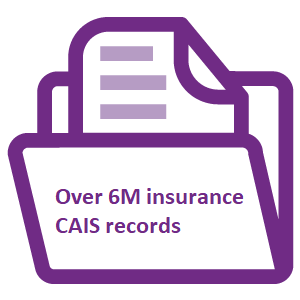What is private credit data?
Full private credit data provides granular financial information about active and closed credit accounts that consumers have been using. This includes information such as:
- Full CRA credit risk score
- Consumer’s indebtedness position
- Payment status and value of credit borrowing (including defaulted accounts)
- Mortgage details
To receive this data, firms must join a closed user group reciprocal data sharing arrangement, where details of credit accounts are shared monthly. The Experian reciprocal data sharing arrangement is Credit Account Information Sharing (CAIS).
CAIS members share data from a variety of different sectors, including: banking, mortgages, unsecured loans, credit cards, vehicle finance, utilities and telecoms. Historically, there has been a relatively small number of insurance CAIS contributors, but this has grown significantly over the last year or so, as more firms from the sector are keen to utilise this data in their processes. Firms using insurance CAIS data include direct insurers, brokers and premium finance providers. Premium Finance providers who use CAIS can also allow their partners, such as brokers who offer finance, to access the Private Credit data under delegated authority.

How does private credit data help?
Insurance CAIS data is typically used to deliver the following benefits:
- Understand a customers’ circumstances better
Private credit data enables firms to gain a more accurate understanding of their customers. This allows firms to present offers, products and terms at POQ (Point of Quote) which are suited to the customer’s needs and current financial position. This in turn reduces cancellations, debt and exposure for the business.
- Appropriate credit risk pricing
Using private credit data, in combination with other data sources, significantly increases predictive power in credit risk scores. Firms can create risk bandings based on these scores. This measure of credit risk could influence the APR% for the premium credit and pricing so that the risk is mitigated and priced appropriately for that customer.
- Helps to satisfy regulation, e.g. affordability checks
Customer insight is enormously valuable when developing strategies to satisfy credit worthiness (including affordability) and financial vulnerability regulation. This has been highlighted by the regulator who published a portfolio strategy letter to all insurance firms who found that some firms are not considering sufficiently the potential costs and risks to consumers of borrowing to fund their insurance cover[1]. As many consumers are currently in a vulnerable position because of the coronavirus pandemic, there is also a level of expectation that insurers be aware of the circumstances that their customers find themselves in and consider their needs very carefully.
How is private credit data used compliantly?
The following criteria must be satisfied to enable the compliant use of full insurance CAIS data:
- Reciprocity: firms must join the CAIS closed user group reciprocal data sharing arrangement. This requires the monthly sharing of all relevant credit agreements.
- Footprints: ‘Hard footprint’ credit searches, visible on a consumer’s credit report, must be reported where consumers open a premium finance agreement and full CAIS data has been used in the process. ‘Soft footprint’ credit searches, not visible on a consumer’s credit report, are recorded for consumers that do not take out premium finance.
- Usage: consumers must be assessed for an offer of premium finance and the CAIS data should be used for making a credit decision.
Having the right data and insight to assess your customers is now more important than ever before. The volatile economy means customers’ needs and financial positions may be changing rapidly and incorporating private credit data gives you greater insight to be able to better serve your customers.
[1] https://www.fca.org.uk/publication/correspondence/letter-firms-personal-commercial-lines-insurer-portfolio-identifying-remedying-harms.pdf
